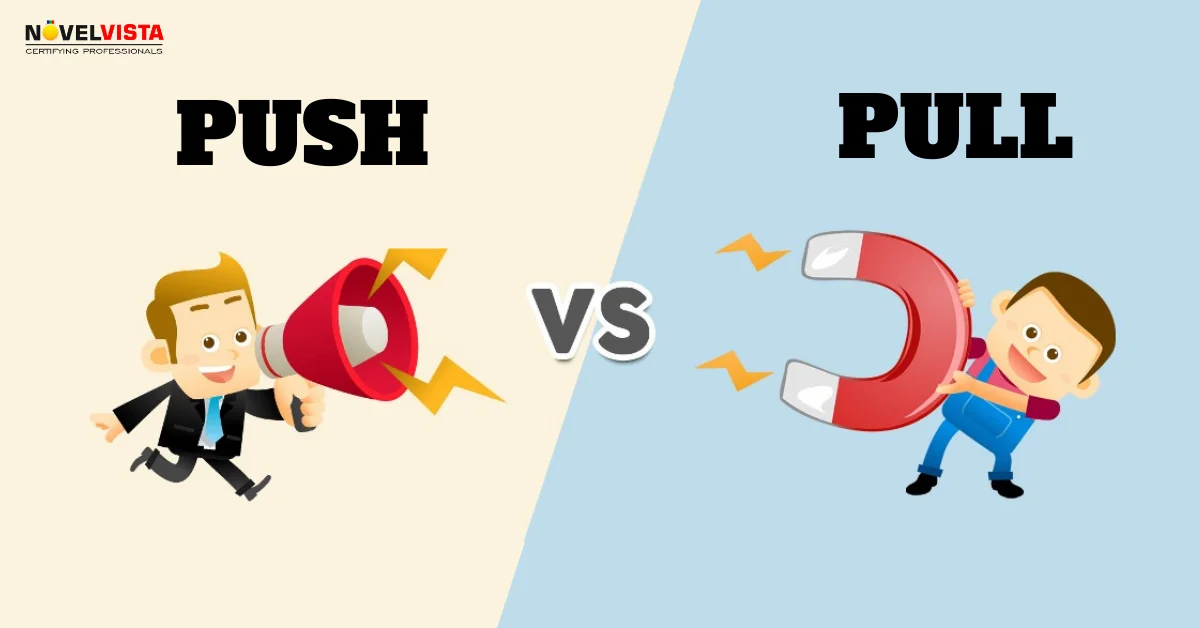Enroll Now and Get Upto 30% Off
* Your personal details are for internal use only and will remain confidential.

Last updated 28/12/2023

Have you ever heard of pull vs push manufacturing? It's about a business which provides physical products; you already use one or a combination of two regardless of how well-versed you are in their meaning. So don't worry; here is everything you need to know about these systems; make sure to stay curious.
The term pull vs push comes from supply chain management. It's a powerful strategy that proves to be excellent for enhancing the accuracy of production processes. It successfully balances the production procedure. It gets done by offering the suitable materials and components to the right place at the right time.
The push system is the manufacturing system, where production is based on the projected production plan, and the details here flow from management to market, such as the maximum retail price. Here, the work is given to an individual, and the entire piece is put into the massive to-do list. In this system, the individual or the group commits to some work in advance.
The Pull System is the manufacturing system, where production is based on daily demands, and the details flow from the market to management. It is like just a time system. It permits the person doing the work to pull in tasks when ready. It prevents individuals from feeling overloaded, and it forces individuals to prioritize.
Following are the different push and pull advantages and disadvantages:
It's essential to understand that push vs pull strategies aren't mutually exclusive, and many businesses use the combination of both systems and methods based on their respective goals and target markets.
Understanding the push and pull advantages and disadvantages and its strategies can support businesses to implement effective marketing and sales approaches to reach their preferred audience and drive accomplishment.
Consumers seek more innovative and high-quality products at lower costs in today's world. It's the only part of the market requirement. On top of this, high delivery reliability, short delivery time, and combined sustainable flexibility are also in demand. To fulfil these requirements, all businesses need to organize themselves accordingly.
Through evolving times, the production and logistics areas play a significant role, and the decisive factor for optimizing the system is the fast and flexible production system, which relies on the real consumers' demand. The Pull System plays a crucial role in fulfilling this requirement and provides advantages over the traditional push system.
MRP is closely linked to both push-pull manufacturing dynamics, which orchestrate product release timing into the market (push), and the retrieval of components or raw materials from the supply chain as demand rises (pull). It also aids in coordinating the production and delivery schedule of a product.
The traditional material requirements planning, MRP I, operates as a push system aligned with a master production schedule derived from projections. In contrast, the contemporary manufacturing resource planning system, MRP II, can be seen as complementary to pull systems. Modern MRP systems might monitor material availability. They also include the production, purchases as soon as a client order us received.
The ERP system assist businesses in manufacturing with different modules which are integrated into the systems. It involves benefits such as supply chain management, inventory management, finance and consumer relationship and management module. Business can use these modules to improve their production.
They can have strong visibility regarding the production steps. Real time insights are shared with the help of common database which is beneficial factor. To combine, the modern ERP and MRP systems works well with the business management tools in both pull and push systems. They are significantly effective for hybrid push-pull systems.
Kanban system is mostly used in the Pull System or processes to control the overall flow of the materials or the production. The comprehensive Kanban system where external suppliers are connected can be prone to errors and is not very clear simultaneously. An electronic kanban system can provide better recommendations to support and optimize the procedure in such conditions. It's also known as E-Kanban.
Imagine one of the easiest, most simple visual methods and processes to control the production procedure without central planning and control of complex ERP/MRP systems or other SCM systems. Now, it's unthinkable, but many world-class businesses have proven that consumption-based processes can be realized with the help of KanBan System.
Unfortunately, the manual Pull system can reach its limits quickly, and it can be one of the disadvantages. The employee's efforts for the software and technical support of the procedure can be significantly decreased by facilitating daily management of the Kanban system.
Also, it makes the procedure more transparent and safer. The visualization and targeted evaluation's versatility helped the procedure and the whole system to become noticeable and helped enhance them continuously. So, E-Kanban is becoming essential for those companies who want to gain a constant pull system.
An electronic Kanban is the term which elaborates the decentralized control systems which are based on the fetch principle and connecting electronic systems. Because of their complexity and variety of alternatives, the electronic Kanban system that is the software support for traditional manual Kanban systems. It can help to counteract problems.
Specifically, the E-Kanban-driven pull system can be adjusted continuously and enhanced based on the Plan Do Check Act cycle as the pulled system is being used everywhere in E-Kanban. So, it can become the robust universal tool for all lean production activities for the future to ensure a business's long-term competitiveness.
Improved efficiency naturally leads to the next Kanban advantage, its increased productivity as well as efficiency. It benefits the productivity through shifting the concentration from starting work to finishing work.
Traditional management methods involve planning and delegating work to your team. Due to this, couples are required to do more work than they have time for. In Kanban, tasks are only pushed into the workflow when the team can complete them.
As we saw above, the Pull System allows Just-in-time delivery of work. Other conflicting work procedures help the group work on different things simultaneously. A pull system allows the team members to concentrate on one thing at a time. Pull Systems has some key attributes, which are mentioned above in the benefits of E-Kanban.
So, when something changes that impact the business requirement, the team can quickly adapt by knowing that most of the work has already been accomplished and can still be applied to the project. Groups using the pull system become self-managed teams to a certain extent due to the system's ability to scale up the team or accommodate different-sized projects while remaining consistent.
The Kanban push and pull system becomes inevitable regarding agile frameworks, methodologies, and processes. A push-based supply chain is based on expected and projected demand. Things are only produced in response to a request in a pull-based supply chain. However, this explanation runs the risk of being overly simplistic. Due to their complexity, both systems are more challenging to implement.
In the Agile world, the Pull system is common, which brings freedom to the entire project team as the actual production is based on daily requirements, and it supports the team not feeling overloaded. Besides this, you can also explore other certifications, such as Kanban certifications and agile certifications
Topic Related PostAbhishek Mishra aims to create a new platform or forum to facilitate discussion when people or leaders feel stuck and confused or unable to add value. He wanted to create a platform where people help and support each other, where there is no gender differentiation and where people become role models for each other. As a writer, he has been accomplished and accolades in several platforms for expressing his feelings through his words. He has written multiple articles that many professionals liked over platforms like LinkedIn, PModay.co.uk, PM Times, and Medium.com. When he is not writing books, you can find him doing project management. When he is not doing either of these, then you can find him trying out new cuisines. He is good at cooking and cooked multiple cuisines to date, but he has a specialization in baking fabulous cakes. Oh, man! It would be best if you tried his cakes and pastries. He is the kind of person who has loads of energy and does not like to sit idle. His first book, The Book of Powerful & Exceptional Quotes, launched in May-2020, the second book, Stereotypical Leadership, Launched in July, the third book, Envisioning PMO & Project Management through a Jugglers Eye, is scheduled to be launched on 27th Dec 2020 He has got stunning writing skills, Culinary skills, and strong management skills; not just that, he is also a process-oriented person. In a way, he always keeps trying different things, and this shows his inquisitive nature too. Professionally he is a seasoned project manager with 14+ years of experience; he has been associated with multiple non-profitable groups to learn and discover ways to help the community and society.
* Your personal details are for internal use only and will remain confidential.